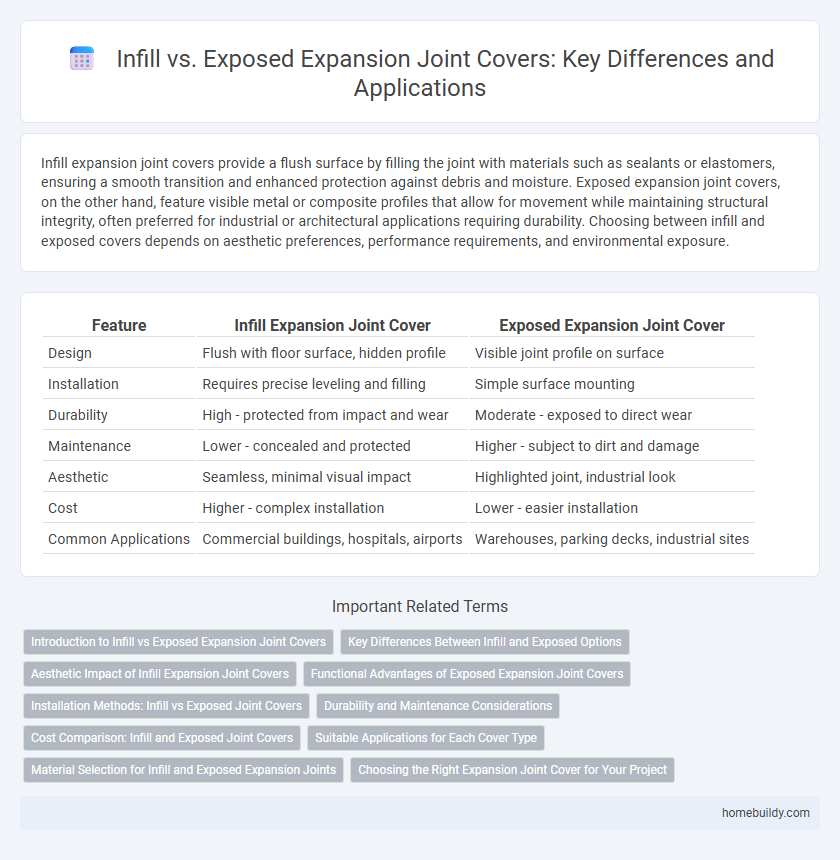Infill expansion joint covers provide a flush surface by filling the joint with materials such as sealants or elastomers, ensuring a smooth transition and enhanced protection against debris and moisture. Exposed expansion joint covers, on the other hand, feature visible metal or composite profiles that allow for movement while maintaining structural integrity, often preferred for industrial or architectural applications requiring durability. Choosing between infill and exposed covers depends on aesthetic preferences, performance requirements, and environmental exposure.
Table of Comparison
| Feature | Infill Expansion Joint Cover | Exposed Expansion Joint Cover |
|---|---|---|
| Design | Flush with floor surface, hidden profile | Visible joint profile on surface |
| Installation | Requires precise leveling and filling | Simple surface mounting |
| Durability | High - protected from impact and wear | Moderate - exposed to direct wear |
| Maintenance | Lower - concealed and protected | Higher - subject to dirt and damage |
| Aesthetic | Seamless, minimal visual impact | Highlighted joint, industrial look |
| Cost | Higher - complex installation | Lower - easier installation |
| Common Applications | Commercial buildings, hospitals, airports | Warehouses, parking decks, industrial sites |
Introduction to Infill vs Exposed Expansion Joint Covers
Infill expansion joint covers integrate materials such as metal, rubber, or elastomer within the joint, providing a flush, finished surface ideal for seamless flooring transitions and enhanced structural flexibility. Exposed expansion joint covers, characterized by visible metal or rubber strips, are designed for applications requiring easy access and maintenance, often utilized in parking decks or industrial settings. Both types accommodate building movement and thermal expansion but differ in aesthetics, installation complexity, and maintenance needs.
Key Differences Between Infill and Exposed Options
Infill expansion joint covers feature materials such as rubber, metal, or fabric inserted into the joint to provide a flush, seamless surface that accommodates movement while maintaining aesthetic continuity. Exposed expansion joint covers leave the joint visibly open with metal or elastomeric strips spanning across to protect and seal the joint, offering easier access for inspection and maintenance. Key differences include infill covers' superior aesthetic integration and weather resistance versus exposed covers' enhanced accessibility and simpler installation.
Aesthetic Impact of Infill Expansion Joint Covers
Infill expansion joint covers provide a seamless and flush finish that enhances architectural aesthetics by blending smoothly with surrounding materials such as stone, wood, or tile. Their concealed design minimizes visible disruptions and maintains continuous surface appearance, making them ideal for high-end commercial and residential spaces. This aesthetic integration supports design continuity and adds sophistication, unlike exposed expansion joint covers that can appear more industrial and visually prominent.
Functional Advantages of Exposed Expansion Joint Covers
Exposed expansion joint covers offer superior durability and ease of inspection, allowing for quick identification of wear or damage without dismantling. Their design facilitates efficient accommodation of structural movement, reducing stress on adjoining surfaces and minimizing maintenance needs. These covers are ideal for high-traffic areas where longevity and reliable performance are critical factors.
Installation Methods: Infill vs Exposed Joint Covers
Infill expansion joint covers require precise installation by embedding flexible materials like rubber or silicone into a recessed joint space, ensuring seamless surface integration and effective movement accommodation. Exposed expansion joint covers involve attaching visible metal or aluminum profiles over the joint, which allows for easier inspection and maintenance but can be more susceptible to debris accumulation. Installation of infill covers demands careful surface preparation and material curing, while exposed covers require secure anchoring and alignment for durability.
Durability and Maintenance Considerations
Infill expansion joint covers offer superior durability due to their recessed design, which protects them from heavy foot and vehicular traffic, reducing wear and tear. Exposed expansion joint covers are more susceptible to damage and require frequent maintenance because their components are fully visible and directly impacted by environmental factors. Choosing infill covers minimizes maintenance costs and extends service life in high-traffic or harsh conditions.
Cost Comparison: Infill and Exposed Joint Covers
Infill expansion joint covers typically incur higher upfront costs due to customized fillers and integration with surrounding materials, whereas exposed expansion joint covers offer lower installation expenses with readily available components. Maintenance costs for infill covers tend to be reduced over time because of their protective, embedded design that minimizes debris accumulation and wear. Exposed covers may require more frequent upkeep and replacements due to direct exposure to environmental factors, influencing long-term cost-effectiveness.
Suitable Applications for Each Cover Type
Infill expansion joint covers are ideal for environments requiring a flush surface with aesthetically pleasing finishes, such as office buildings, hospitals, and shopping malls where pedestrian traffic is high. Exposed expansion joint covers suit industrial areas, parking garages, and rooftop decks where durability and easy access for maintenance are critical. Choosing the appropriate cover type depends on load capacity, aesthetic requirements, and exposure conditions specific to each application.
Material Selection for Infill and Exposed Expansion Joints
Infill expansion joint covers typically utilize flexible materials such as rubber, neoprene, or silicone to accommodate movement while providing a seamless surface integration. Exposed expansion joint covers often incorporate robust metals like aluminum or stainless steel combined with elastomeric seals, ensuring durability against environmental exposure and mechanical wear. Selecting the appropriate material depends on factors like joint movement range, aesthetic requirements, and exposure conditions to optimize performance and longevity.
Choosing the Right Expansion Joint Cover for Your Project
Selecting the right expansion joint cover involves understanding the key differences between infill and exposed types to meet structural and aesthetic needs. Infill expansion joint covers feature concealed joints filled with flexible materials, providing a sleek finish ideal for interior applications and high-traffic areas due to their durability and low maintenance. Exposed expansion joint covers, on the other hand, highlight visible joint components designed for exterior use, offering easier access for inspection and repair while accommodating larger movement ranges in building structures.
Infill expansion joint cover vs Exposed expansion joint cover Infographic

 homebuildy.com
homebuildy.com